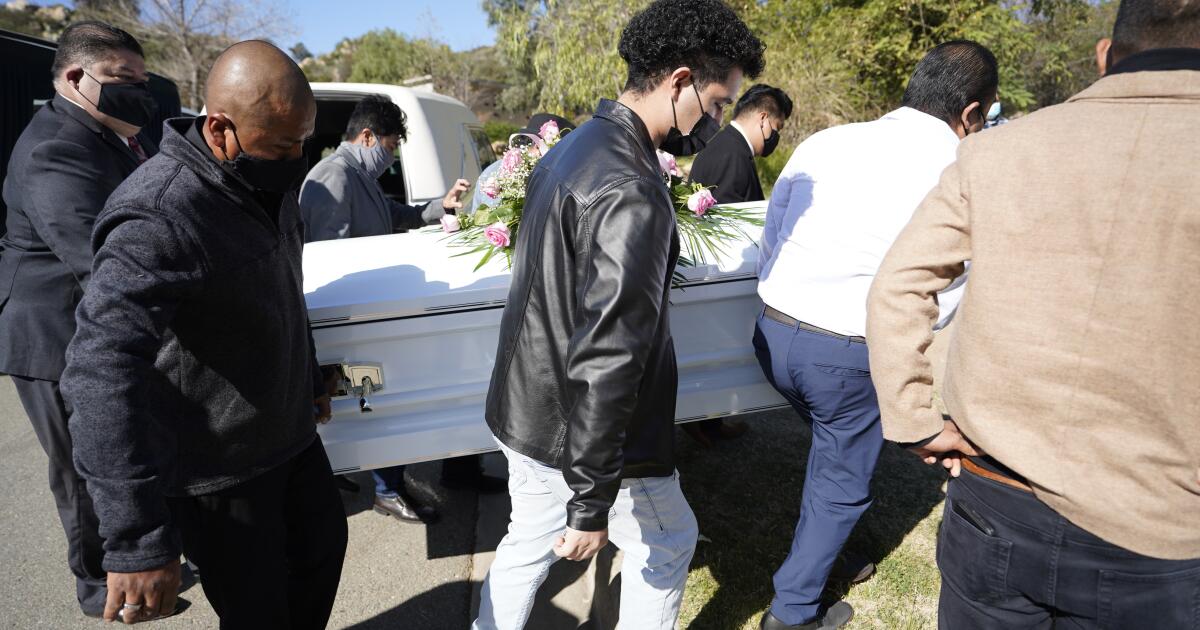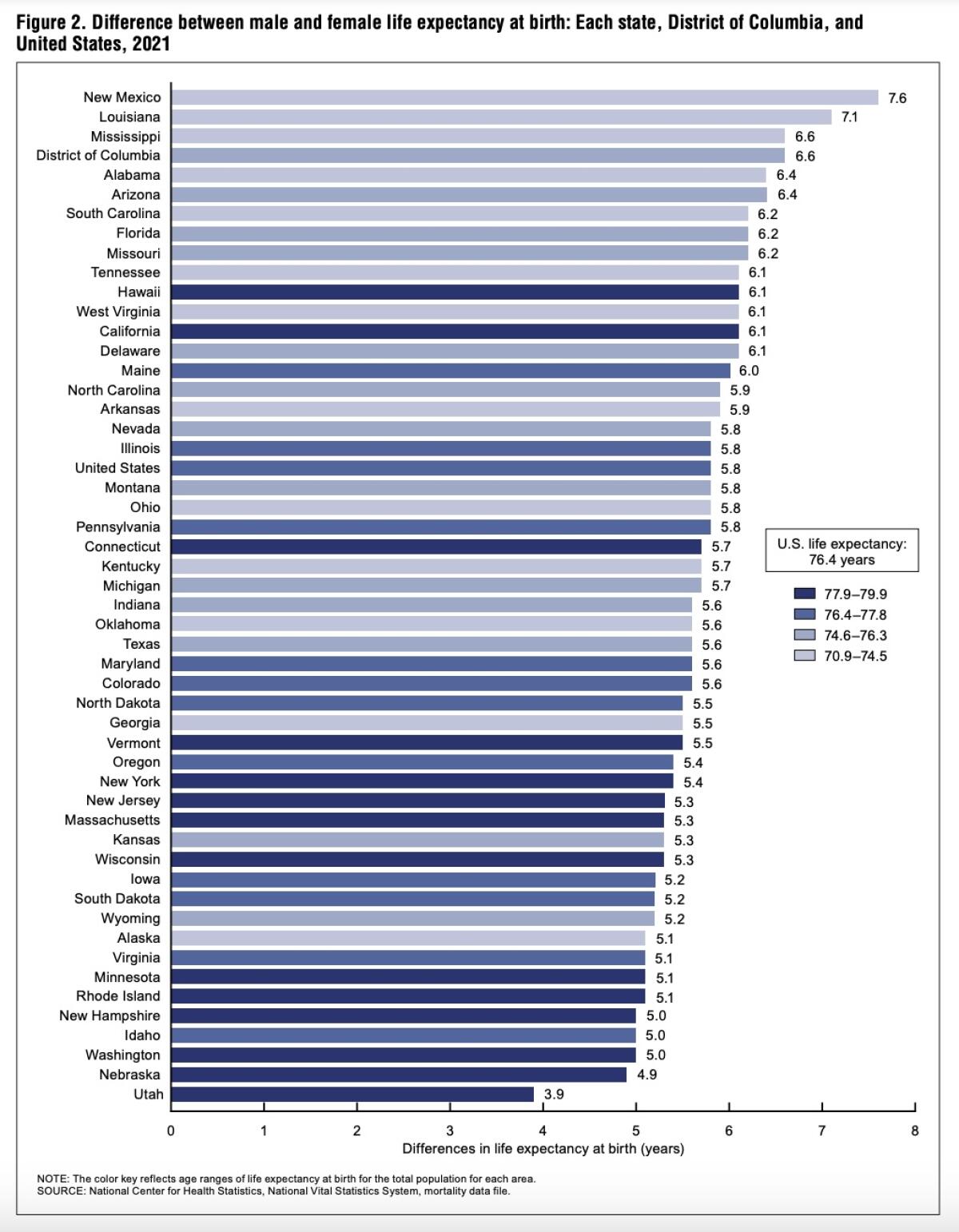California
See COVID’s toll on California’s life expectancy in new CDC longevity report

It was the year COVID-19 vaccines became widely available, and the pandemic’s startling death toll in California and elsewhere appeared close to being reined in.
Instead, life expectancy in California fell by more than 8 months in 2021, dropping the Golden State to 10th place in the nation, according to a new report from the Centers for Disease Control and Prevention.
An analysis of all 50 states and the District of Columbia found that babies born in California in 2021 could expect to live 78.3 years — down from 79 years in 2020, when California ranked fourth in the nation.
The decrease, which was reported Wednesday by the CDC’s National Vital Satistics System, revealed that the promise of COVID-19 vaccines — along with other public health measures — was not enjoyed uniformly across the nation.
While life expectancy dropped in California and 38 other states, it increased in 11 others and held steady in the District of Columbia. (New Jersey logged a gain of 1.5 years between 2020 and 2021, the best performance among the states.)
In 2019, before the coronavirus reached U.S. shores, the state’s overall life expectancy at birth was 80.9 years, with an expected life span of 78.4 years for men and 83.3 years for women. That put California in the No. 2 spot, just slightly behind Hawaii. (The states were so close that Hawaii’s overall life expectancy that year was also reported as 80.9 years.)
Then deaths during the first year of the pandemic shaved 1.9 years off California’s life expectancy at birth. Only 15 states weathered larger declines. (New York saw the biggest drop, losing 3 full years of life expectancy between 2019 and 2020.)
Expected life spans in the Golden State shrank by another 0.7 years in 2021, according to the new report. That was the 27th-largest decline, putting it in the middle of the pack. (The biggest drop was in Alaska, where it plunged from 76.6 to 74.5 years.)
This map divides states into quartiles based on their life expectancy at birth for 2021. The darker the state,the longer the life expectancy.
(National Center for Health Statistics, National Vital Statistics System)
The life expectancy of Americans as whole fell by 0.6 years to 76.4 years, according to the new report. CDC researchers attributed that decrease primarily to high numbers of COVID-19 deaths and fatalities from accidental drug overdoses.
Hawaii retained the longevity crown in 2021, with a life expectancy of 79.9 years.
That was a full 9 years longer than in Mississippi, which ranked 51st among all states and the District of Columbia. A baby born in the Magnolia state could expect to live 70.9 years, according to the new report.
The states that rounded out the top five overall in 2021 were Massachusetts (79.6 years), Connecticut (79.2 years), New York (79.0) and New Jersey (also 79.0).
Joining Mississippi at the bottom of the list were West Virginia (71.0 years), Alabama (72.0 years), Louisiana (72.2 years) and Kentucky (72.3 years).
More broadly, “states with the lowest life expectancy at birth were mostly Southern states,” the report said. “States with the highest life expectancy at birth were predominantly Western … and Northeastern states.”
Women were expected to outlive men in every state in 2021. The life expectancy gap ranged from a high of 7.6 years in New Mexico to a low of 3.9 years in Utah. The average gender gap for the country as a whole was 5.8 years, according to the report.
In California, the expected lifespan was 81.4 years for a baby girl born in 2021 and 75.3 years for a baby boy — a difference of 6.1 years.
For the most part, the states with the largest differential between the sexes had lower life expectancies overall. Meanwhile, states with the smallest discrepancies between males and females tended to have higher overall life expectancies, the CDC noted.

This chart ranks states according to the size of their gender gap for life expectancy at birth in 2021. New Mexico had the biggest discrepancy, while Utah had the smallest.
(National Center for Health Statistics, National Vital Statistics System)
CDC researchers also calculated the remaining lifespan for Americans who were 65 years old in 2021. The nationwide average was 18.4 years — 17.0 years for men and 19.7 years for women.
Life expectancy at 65 is always greater than life expectancy at birth because the pool of people who survive to their 65th birthday excludes those who weren’t able to reach that milestone.
The risk of death in the first year of life is particularly high — the U.S. infant mortality rate in 2021 was 5.44 deaths per 1,000 live births — and actuarial life tables from the Social Security Administration show that it takes until age 49 for the mortality rate to reach the same level.
In 2021, 65-year-olds in Hawaii had the most years to look forward to, with an average remaining life expectancy of 20.6 years. That was followed by Connecticut at 19.9 years, Massachusetts at 19.6 years, and Minnesota, New York, Vermont and New Jersey at 19.4 years.
Mississippi ranked 51st on this longevity list as well, offering 65-year-olds an expectation of 16.1 more years to live. West Virginia also had a remaining life expectancy of 16.1 years, followed by Alabama, Oklahoma and Kentucky at 16.4 years.
California beat the nationwide averages for 65-year-olds with a remaining overall life expectancy of 19.3 years. That included 17.8 additional years for 65-year-old men and 20.7 years for 65-year-old women.

California
California Highway Patrol warns against attempted ‘Amber Alert' scam

The California Highway Patrol is warning the public to beware of fraudsters posing as “AMBER Alert representatives” offering to “register” children.
“They ask for confidential info and to meet at your home,” the CHP said Saturday on social media. “This is not how the AMBER Alert system works.”
No registration is ever required, the CHP said.
AMBER — which stands for America’s Missing: Broadcast Emergency Response — is only activated by law enforcement agencies investigating reports of an abducted or missing child.
The alerts are intended to provide the public with immediate information about a child abduction.
The CHP said it is the only agency authorized to activate AMBER Alerts.
“Never provide personal information or answer calls from unknown or ‘possible scam’ numbers,” the highway patrol said.
If contacted by a scammer, the CHP said, report it to your local law enforcement agency immediately.
California
Opinion: California utilities have lofty climate goals. Too bad their customers are in the dark

Regardless of the presidential election results, the clean energy transition is still a major priority for the nation’s electric utilities. Perhaps nowhere in the world is the pressure more intense than in Southern California, where the demands on the power grid are high and many residents are well acquainted with the consequences of aging, unsuitable infrastructure.
Many electric utilities now consider sustainability crucial to their overall strategy. However, as evidenced by countless examples of conservatives being elected on anti-environmental platforms, the majority of consumers just aren’t thinking that much about clean energy.
For the past four years, my team at J.D. Power and I have been analyzing customer awareness of and support for utilities’ climate programs and goals in an annual Sustainability Index. Without fail, we found that very few customers have any awareness of their utilities’ clean energy goals. This year’s index found that just 22% of customers knew their utilities had such goals, a figure that was even lower in previous years.
I experienced one aspect of this phenomenon as a consumer when I went through the grueling process of learning about and applying for California and federal rebates for an energy-efficient heat pump system I installed in my home last year. Even though I wrote about that ordeal for The Times and heard from consumers who had similar experiences, I have yet to get any response from my utility. Heat pumps have been a cornerstone of clean energy transition efforts, but when it comes to installing and using them and understanding their benefits, utilities are leaving consumers on their own.
A deep dive into my combined electric and gas bills showed that my total expenses dropped 3% in 2024 compared with the same period in 2022, before I began installing the system. And because average unit electricity prices increased by more than 20% in the interim, my adjusted heating costs are down more than 23%. In addition, I now have the benefit of air conditioning during summer heat waves, which I did not have prior to the conversion.
But before I could even begin to understand the extent of these benefits, I had to download reams of data from Pacific Gas & Electric Co.’s data hub, build a spreadsheet to organize and chart my energy use and utility billing trends, and cross-reference everything with federal greenhouse gas equivalency calculations. Does anyone think an average consumer would go through all this?
The experience illustrated the chasm between the way utilities communicate about environmental responsibility and the way consumers live it. The fact is, if any utilities are ever going to meet their sustainability targets — many of which call for reaching net zero greenhouse gas emissions by 2030 — they are going to need their customers to change their behavior. But given that few customers are even aware of these priorities, and that most are far more concerned about affordability than they are about sustainability, there is a complete disconnect between utility and customer goals.
But these goals can be aligned if the companies explain and promote them clearly and convincingly. We’re living through a historic transformation that has the potential to reinvent heating and cooling, travel and more. Smart-grid technologies can put individual homeowners at the center of the energy storage and transmission system. None of that will happen without massive consumer buy-in.
Utilities should be launching bold outreach strategies, investing in customer education on how to save money (and pollution) by adopting new technologies, and making it easy for consumers to help them reach their environmental goals. But most utilities are instead wasting their time talking about lofty sustainability targets that lack the substance and support they need to become reality.
Electric utilities have a huge opportunity to help customers save money and improve their experience, increase their own revenue and meet their clean energy goals. To do so, they need to start understanding and communicating effectively with their customers.
Andrew Heath is the vice president of utilities intelligence at J.D. Power.
California
California’s new ‘Daylighting’ law forces change to Davis parking

-

 Health1 week ago
Health1 week agoNew Year life lessons from country star: 'Never forget where you came from'
-
/cdn.vox-cdn.com/uploads/chorus_asset/file/24982514/Quest_3_dock.jpg)
/cdn.vox-cdn.com/uploads/chorus_asset/file/24982514/Quest_3_dock.jpg) Technology1 week ago
Technology1 week agoMeta’s ‘software update issue’ has been breaking Quest headsets for weeks
-

 Business5 days ago
Business5 days agoThese are the top 7 issues facing the struggling restaurant industry in 2025
-

 Politics1 week ago
Politics1 week ago'Politics is bad for business.' Why Disney's Bob Iger is trying to avoid hot buttons
-

 Culture5 days ago
Culture5 days agoThe 25 worst losses in college football history, including Baylor’s 2024 entry at Colorado
-

 Sports4 days ago
Sports4 days agoThe top out-of-contract players available as free transfers: Kimmich, De Bruyne, Van Dijk…
-

 Politics3 days ago
Politics3 days agoNew Orleans attacker had 'remote detonator' for explosives in French Quarter, Biden says
-

 Politics3 days ago
Politics3 days agoCarter's judicial picks reshaped the federal bench across the country














